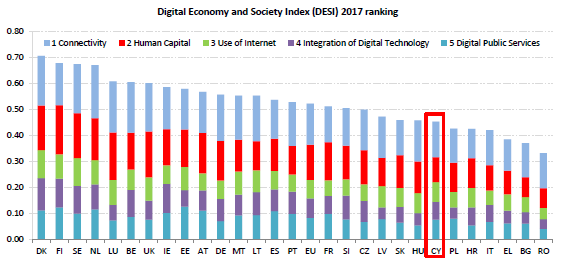Businesses have no choice but to digitally transform. CIM Academic Director Dr Myria Kkali lays out challenges and opportunities for business undergoing digital transformation.
What is Digital Transformation?
Digital transformation is defined as the realignment of, or new investment in, technology and business models to more effectively engage digital customers at every touchpoint in the customer experience lifecycle. Successfully incorporating today’s digital technologies requires companies to operate in new ways. As Charles Darwin put it: “It is not the strongest of the species that survives, but the one that is best able to adapt to the changing environment in which it finds itself”. Therefore, digital transformation is no longer a choice for organisations, but a necessity as companies move into new ways of doing business in the digital era. It is important to note here, that digital transformation refers to changes in product innovation, to new ways of re-focusing on consumer experience delivery but also to internal restructuring of business practices and company culture.
The Benefits of Digital Transformation
Digital Transformation is a new concept, and it’s still early, but so far the evidence for companies leveraging digital technology is encouraging, with many expected benefits such as:
- Reduced costs
- Improved customer strategy
- Consolidated operations
- Better analytics
- More customer-centric focus
- New products/services
- Accurate market segmentation
- Universal customer experience
- Increased agility and innovation
Do it like Starbucks
One company that has succeeded in adopting digital transformation for business growth is Starbucks. In 2009, after low performance cut the company’s stock price in half, Starbucks looked to digital to help re-engage with customers. It restructured its internal operations and created a department for digital ventures. Starbucks started offering free Wi-Fi in Starbucks stores, along with a digital landing page with a variety of digital media choices, including free content from publications like The Economist, in an effort to do something innovative around how they were connecting with customers. Another strategic digital move was to make digital transactions faster, by cutting 10 seconds from every card or mobile phone transaction, reducing time-in-line by 900,000 hours. Starbucks is also adding mobile payment processing to its stores, and is processing 3 million mobile payments per week. Soon, customers will order directly from their mobile phones. Using social media, mobile and other technologies to change customer relationships, operations and the business model has helped Starbucks re-engage with customers and boosted overall performance. As a result of these changes amongst others, its stock price has also bounced back up from roughly $8 in 2009 to nearly $58 in July 2018 as traded on the NASDAQ stock market.
Different levels of digital business maturity
Not all organisations are of the same level of digital maturity as Starbucks. A study by Westerman et al. (2012) categorised organisations in 4 distinct categories, according to their digital maturity.
- Beginner companies probably use email, Internet and various kinds of enterprise software. But they have been slow to adopt, or are sceptical of, more advanced digital technologies like social media and analytics.
- Conservative companies deliberately hang back when it comes to new technologies, although their management has a vision and effective structures in place to govern technology adoption.
- Fashionista companies are very aggressive in adopting new technologies, but do not coordinate well across departments or have an effective vision in place for dealing with digital business.
- Digirati companies have executives that share a strong vision for what new technologies bring, invest in and manage digital technologies quickly and effectively, and gain the most value from digital transformation.
A study by MIT Centre for Digital Business and Capgemini Consulting found that only 15% of respondents were in the most mature category alongside Starbucks (as indicated in Figure 1 below). Sixty-five percent of respondents are in organizations that rank as least mature — the category the index refers to as Beginners.

Executing the change
Therefore, not all companies and organisations are embracing change and digital transformation, with some rejecting it and some being very sceptical about its value. So, how can they execute the change in the most effective way? A survey by MIT Sloan Management Review asked the question: How are digital technologies changing the way companies do business?Findings revealed that simply implementing or using digital technologies is not enough. The key to successful digital transformation is less a question of technology than of strategy, culture and talent development. Furthermore, many survey respondents question whether their company’s leadership has the skills and abilities to lead the organization in a digital environment.
While each organisation leverages its technology differently, there are a few universal keys to making the most of digital transformation. Firstly, old and new technology must connect. Digital transformation and innovation can only be as effective as the rest of your technology allows it to be, so understanding current workflows and how technology impacts them is critical. Next, companies must review operating model differences and their speeds, agility, fluidity, and customer involvement ahead of time to prevent problems from occurring down the road. Technology investments or failures of the past should not affect future adoption.
Furthermore, a new organisational culture must be established, making sure that employees believe in the potential of digital transformation. A workforce needs appropriate training and continuous learning opportunities to cultivate the knowledge and skills necessary for maximizing digital transformation’s impact. As seen in Figure 2 below, entrenched attitudes of fear and ignorance beat down digital transformation within many corporate cultures. According to the study conducted by MIT Sloan, more than 20% of respondents said that internal politics, including fear of losing power in the organization, impeded adoption of digital technology. Therefore, during this transitional period, the coexistence of two different models (old and new) has the potential to slow down operations and bring decision-making into question. These negatives only get worse without open lines of communication. Organizational leaders should communicate clear expectations regarding employee responsibility and accountability on a continuous basis to minimise disruptions.
Lastly, among the obvious obstacles to digital transformation is lack of clarity about the pay-off. Companies want to know that they are getting something beneficial from investment in new technologies. Corporate leaders need to leverage metrics to help make digital transformation happen.

Europe’s Digital Progress Report 2017
Cyprus ranks 22nd in Digital Economy and Society Index (DESI) 2017 announced by the European Commission (see Figure 3). Compared to 2016, Cyprus showed significant progress in connectivity. The digital scoreboard measures the performance of Europe and the Member States in a wide range of areas, from connectivity and digital skills to the digitisation of businesses and public services. The delivery of online public services is close to EU average. Despite the fact that internet users engage in a wide variety of online activities, low levels of digital skills risk acting as a brake to the further development of its digital economy and society. Although Cyprus is among the countries that have recorded the greatest progress during the last four years, along with Ireland and Spain, it is still among the low-ranking countries.In relation to this, the Government has announced its plans to support the private sector whilst also intensifying the public sector’s digital transformation efforts to improve Cyprus’ position in the index. One such measure of support, as stated by Cyprus Transport and Communication Minister, Vassiliki Anastasiadou, is to implement the legislation on ultra-fast broadband networks included in the Directive on the European Electronic Communications Code. The government, she added, was constantly developing new e-services and improving existing ones. According to the minister, the e-government council has approved projects worth over €200m for the next three years.

Concluding thoughts
As more and more companies transform themselves, the potential is exciting and the possibilities are largely untapped. Digital technology has the potential to revolutionize industries, so company executives should not be afraid to think outside the box and try something new. Taking small steps towards digital transformation, with a strategic plan in mind, is the right way to go. The only wrong move for executives, would be not making any move at all, since they will find themselves and their business models outdated and replaced by companies ready to take the challenge.
In conclusion, this article aimed to provide an overview of the concept of Digital Transformation, and discuss the challenges and opportunities it comes along with. In the next instalment, we will be discussing how start-up businesses of any size can take advantage of Digital Transformation to create their competitive advantage when establishing themselves in the market.




